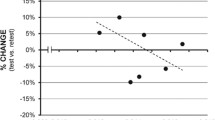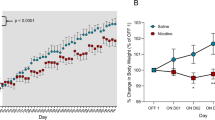Abstract
Anorectic effects of apomorphine were studied in a microstructural analysis paradigm. Low doses of apomorphine (<0.1 mg/kg SC) reduced food intake, by reducting both the rate of eating and eating time. The neuroleptics haloperidol and thioridazine blocked the effect of apomorphine on eating time, but not on eating rate. Anorectic effects elicited by apomorphine administration to the ventral tegmental area and, to a lesser extent, the substantia nigra were mediated by a selective reduction of eating time. Effects of apomorphine on eating time appear to result from an action at presynaptic dopamine receptors; the mechanism of the effect of apomorphine on eating rate is unclear.
Similar content being viewed by others
References
Bentall AC, Herberg LJ (1980) Blockade of amphetamine-induced locomotor activity and stereotypy in rats by spiroperidol but not by an atypical neuroleptic, thioridazine. Neuropharmacology 19:699–703
Blundell JE, Latham CJ (1978) Pharmacological manipulation of feeding behaviour: possible influences of serotonin and dopamine on food intake. In: S Garattini and R Samanin (eds) Central mechanisms of anorectic drugs, New York: Raven Press, pp 83–109
Blundell JD, Latham CJ (1980) Characterisation of adjustments to the structure of feeding behaviour following pharmacological treatment: Effects of amphetamine and fenfluramine and the antagonism produced by pimozide and methergoline. Pharmacol Biochem Behav 12:717–722
Blundell JD, McArthur RA (1981) Behavioural flux and feeding: Continuous monitoring of food intake and food selection, and the videorecording of appetitive and satiety sequences for the analysis of drug action. In: S Garattini and R Samanin (eds). Anorectic agents: Mechanisms of action and tolerance, Raven Press, New York, pp 19–43
Carlsson A (1975) Dopaminergic autoreceptors. In: O Almgren, A Carlsson and L Engel (eds) Chemical tools in catecholamine research, Vol II, Marcel Dekker, New York, pp 49–65
Chiodo LA, Bunney BS (1983) Typical and atypical neuroleptics: differential effects of chronic administration on the activity of A9 and A10 midbrain dopaminergic neurons. J Neurosci 3:1607–1619
Cooper SJ, Francis RL (1979) Feeding parameters with two food textures after chlordiazepoxide administration, alone or in combination with d-amphetamine or fenfluramine. Psychopharmacology 62:253–259
Cooper SJ, Francis RL (1980) Interactions of chlordiazepoxide and anorectic agents on rate and duration parameters of feeding in the rat. Psychopharmacology 69:261–265
Costall B, Naylor RJ (1975) Detection of the neuroleptic properties of clozapine, sulpiride and thioridazine. Psychopharmacologia 43:69–74
Costall B, Naylor RJ, Nohria V (1980) On the ability of apomorphine derivatives to reduce spontaneous locomotor activity in mice. Neurosci Lett suppl 5:S, 462
Costall B, Lim SK, Naylor RJ (1981) Characterisation of the mechanisms by which purported dopamine agonists reduce spontaneous locomotor activity of mice. Eur J Pharmacol 73:175–188
De Castro JM (1981) The stomach energy content governs meal patterning in the rat. Physiol Behav 26:795–798
Di Chiara G, Porceddu ML, Vargiu L, Argiolas A, Gessa GL (1976) Evidence for dopamine receptors mediating sedation in the mouse brain. Nature 264:564–566
Hjorth S, Carlsoon A, Clark D, Svensson D, Wikstrom H, Sanchez D, Lindberg P, Hacksell U, Arvidsson L-E, Johansson A, Nilsson JLG (1982) Pharmacological manipulation of central dopamine (DA) autoreceptors — biochemical and behavioural consequences. In: A Carlsson and JLG Nilsson (eds). Dopamine receptor agonists, Acta Pharmaceutica Suecica Suppl. 1983: 1. Swedish Pharmaceutical Press, Stockholm, 130–137
Kelly PH, Seviour PW, Iversen SD (1975). Amphetamine and apomorphine responses in the rat following 6-OHDA lesions of the nucleus accumbens septi and corpus striatum. Brain Res 94:507–522
Makanjuola ROA, Dow RC, Ashcroft GW (1980) Behavioural responses to stereotactically controlled injections of monoamine neurotransmitters into the accumbens and caudate-putamen nuclei. Psychopharmacology 71:227–235
Montanaro N, Dall'Olio R, Gandolfi O, Vaccheri A (1982) Neuroleptic versus antidepressant activity of sulpiride isomers in the rat. In: E Costa and G Racagni (eds). Typical and atypical antidepressants: Molecular mechanisms, E. Raven Press, New York
Pellegrino LJ, Lushman AJ (1967) A stereotaxic atlas of the rat brain. Appleton-Century-Crofts, New York
Protais P, Bonnet JJ, Costenin J (1983) Pharmacological characterization of the receptors involved in the apomorphine-induced polyphasic modifications of locomotor activity in mice. Psychopharmacology 81:126–134
Skirboll LR, Grace AA, Bunney BS (1979) Dopamine auto- and postsynaptic receptors: Electrophysiological evidence for differential sensitivity to dopamine agonists. Science 206:80–82
Sokoloff P, Martres MP, Schwartz JC (1980) 3H-Apomorphine labels both dopamine postsynaptic receptors and autoreceptors. Nature 288:283–286
Sumners C, DeVries JB, Horn AS (1981) Behavioural and neurochemical studies on apomorphine-induced hypomotility in mice. Neuropharmacology 20:1203–1208
Ungerstedt U (1971) Stereotaxic mapping of the monoamine pathways in the rat brain. Acta Physiol Scand Suppl 367:1–48
White FJ, Wang RY (1983) Comparison of the effects of chronic haloperidol treatment on A9 and A10 dopamine neurons in the rat. Life Sci 32:983–993
Willner P, Towell A (1982) Microstructural analysis of the involvement of beta-receptors in amphetamine anorexia. Pharmacol Biochem Behav 17:255–262
Wiepkema PR (1979) Behavioural factors in the regulation of food intake. Proc Nutr Soc 30:142–149
Author information
Authors and Affiliations
Rights and permissions
About this article
Cite this article
Willner, P., Towell, A. & Muscat, R. Apomorphine anorexia: A behavioural and neuropharmacological analysis. Psychopharmacology 87, 351–356 (1985). https://doi.org/10.1007/BF00432720
Received:
Accepted:
Issue Date:
DOI: https://doi.org/10.1007/BF00432720




